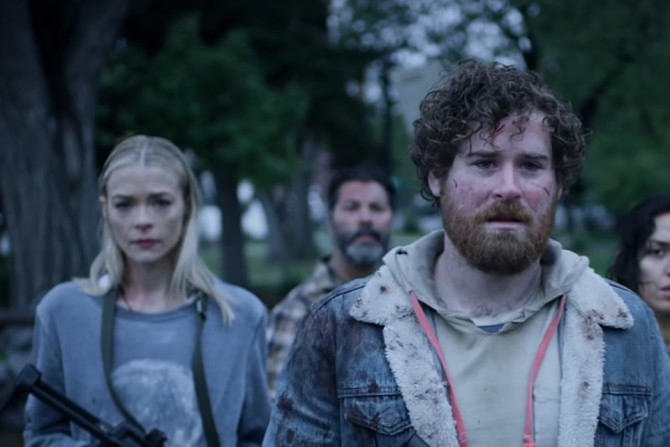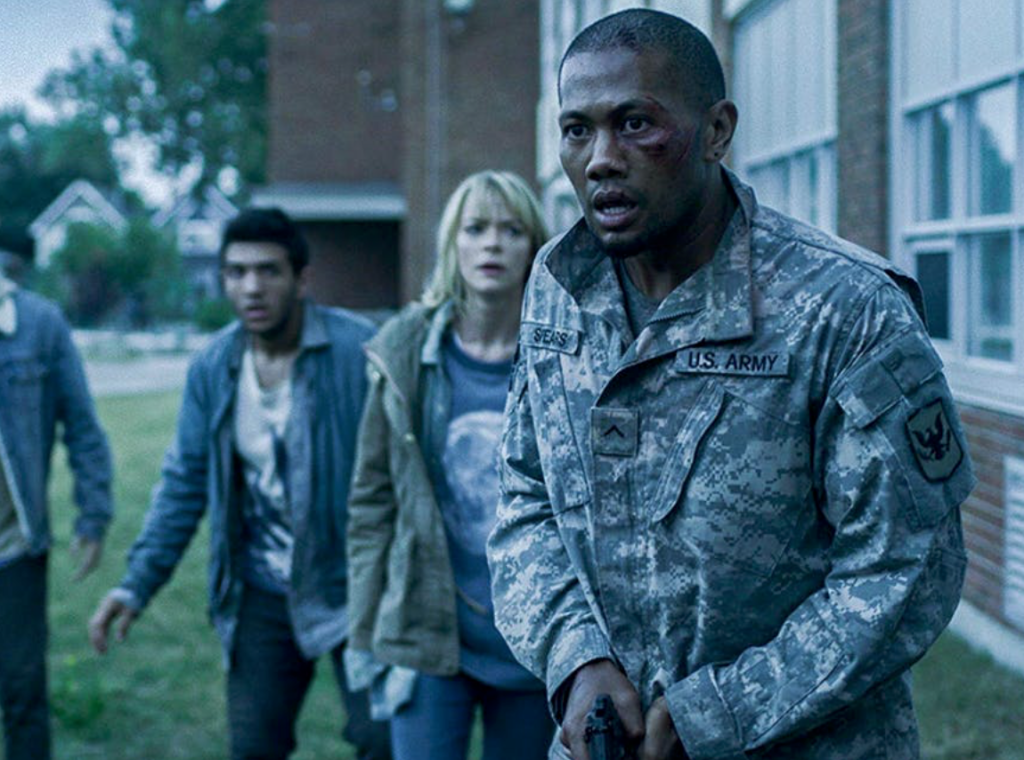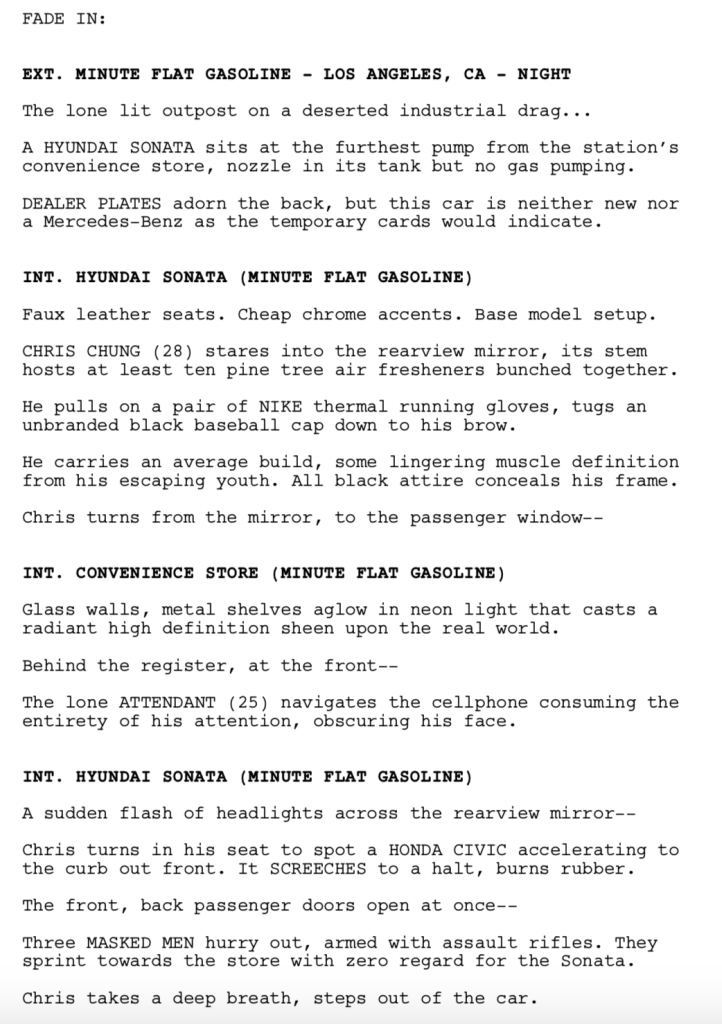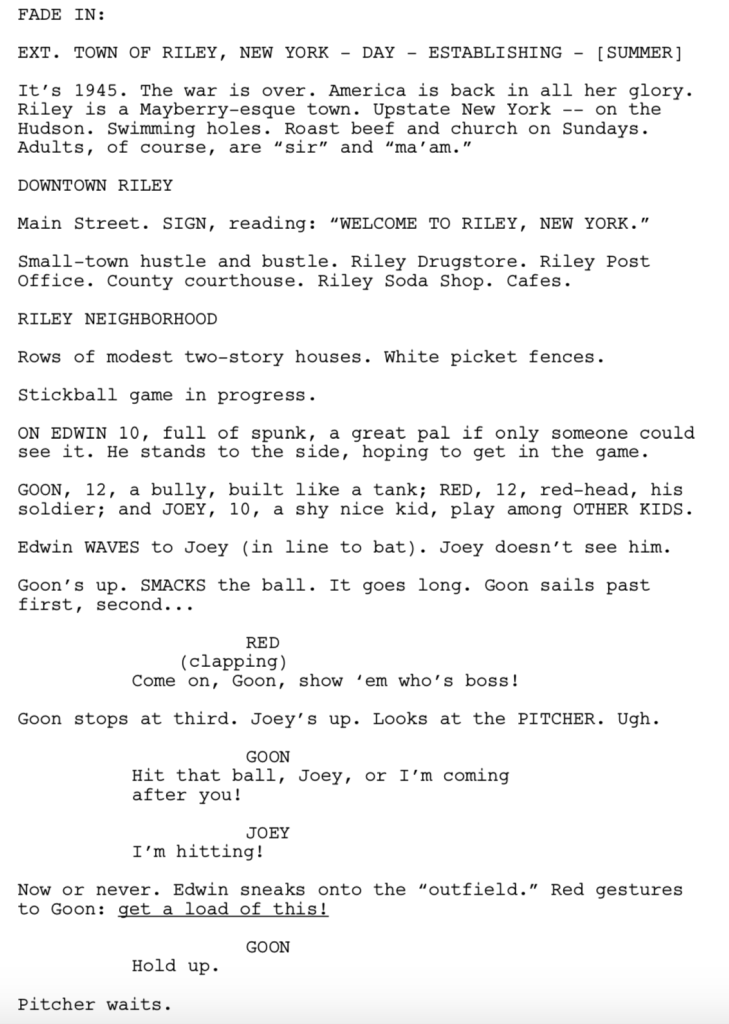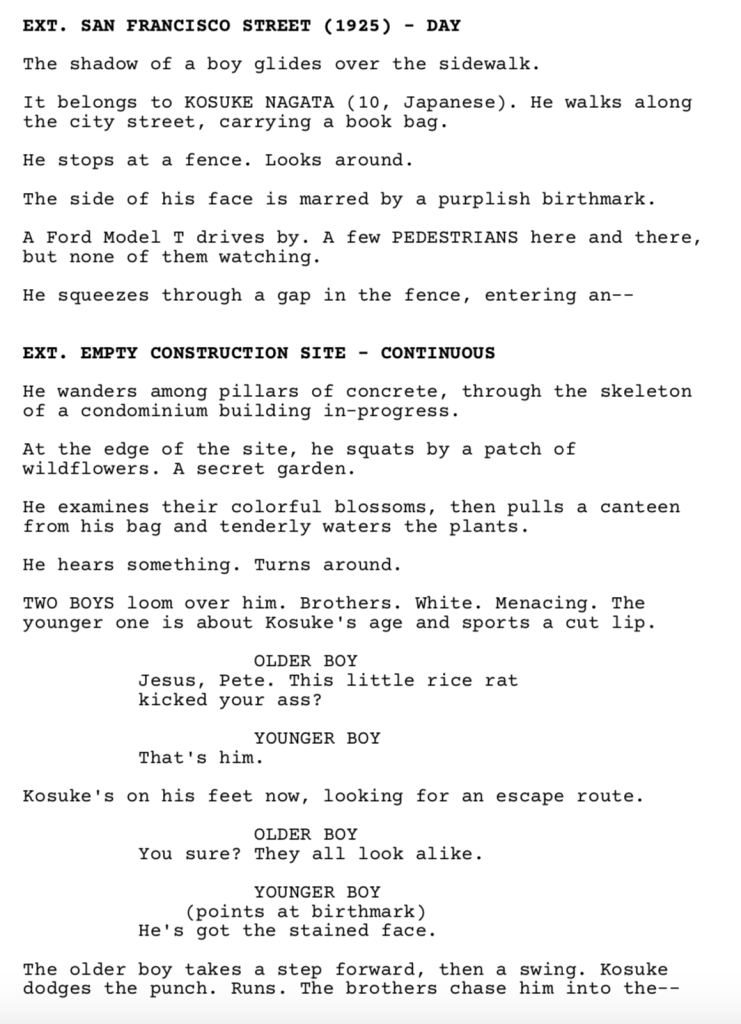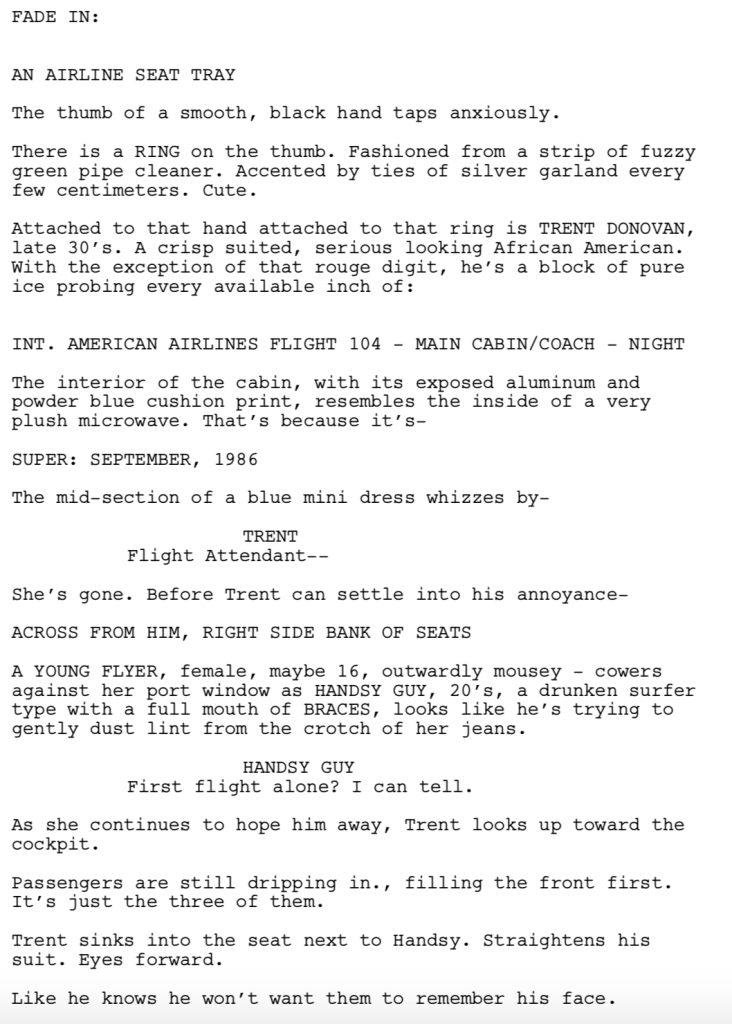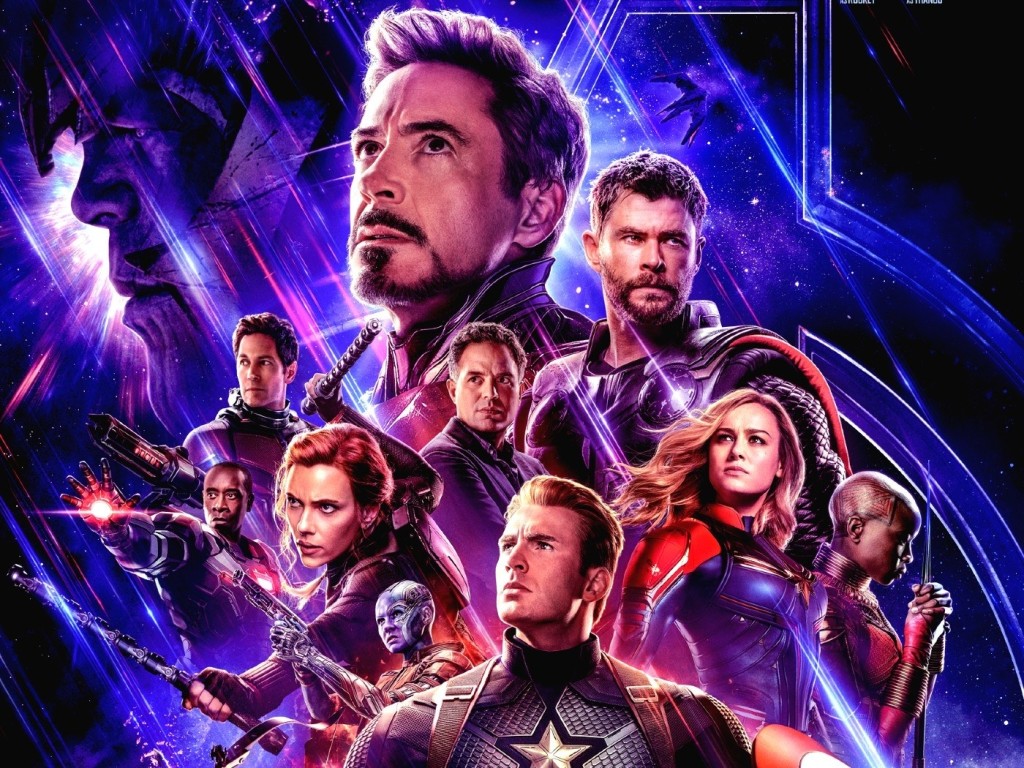Genre: TV – Zombie
Premise: A few weeks after a fierce zombie breakout, groups of people in a [previously] perfect suburban town come together to try and survive.
About: I’ve heard this is connected to the Z Nation zombie series? I don’t know anything about that show so I don’t know how closely the two are linked. But after a quick google search, this seems to be its own show trying to do its own things.
Creators: John Hyams, Karl Schaefer
Details: 8 Episode Series – Netflix
I kept going back and forth on whether I was going to review this show. But then last night I watched the best scene I’ve seen in a movie or TV show all year, and that put me over the top. I had to review it. I’ll get to what that scene was in a second, but first, let’s talk Black Summer.
In many ways, The Walking Dead has destroyed zombies. Not forever. They’ll come back again. But the show dominated the zombie narrative for over half a decade and, once the show went downhill, killed off any excitement for the 50 year old monster.
Naturally, for these reasons, I went into Black Summer skeptically. We’re going to be bouncing around with groups of characters holed up in temporary buildings while dealing with the occasional zombie attack? Umm, isn’t that called The Walking Dead?
But Black Summer makes a few key changes to the format. And while they may seem small individually, when you combine them together, they give us a show that definitely creates its own identity.
The show starts off with a tremendous opening scene. In it, we’re hovering over a quiet suburb in the middle of the day. We cut inside of a house to meet a father, mother, and daughter. They’re scrambling. Scared. The mother tells the daughter to hurry. They have to leave now.
We show them peeking out their door. The peek tells us something dangerous is out there, something predatory. Once they establish it’s safe to go, they start moving. And it’s here where we see everyone is coming out of their houses as well, all scared, all jogging. Jogging towards something. We don’t know what yet.
Finally, we see their destination. A military transport. They’re shuttling people out. However, the soldiers are checking everyone for something before they can get on. A disease? It’s hard to tell. Finally, a soldier exposes that our father character is injured. His gut is bleeding. The mom starts freaking out. Trying to explain that he’s okay. Meanwhile, the daughter has already passed through security. The squabble gets bigger. More people get involved. And now gunshots. And then the transports are leaving. The mother is screaming. She grabs her husband. They escape to a house. But it’s too late for him. He dies. And then he turns. And then she runs. Because if she doesn’t, she’ll be just like him.
That’s the beginning of Black Summer.
Eventually, the mother joins up with a group. A criminal masquerading as a soldier. A mute man. A cowardly hipster. And soon we learn what everyone’s so afraid of. Zombies. But these aren’t your moaning groaning Walking Dead zombies. These things are relentless. They’re sprinters. Can appear out of anywhere and be on top of you within seconds. You don’t get to line up the perfect headshot with these slow-pokes. You have to shoot frantically, never hitting your target where you want.
It was these two elements that got me hooked on the show.
Number one, Black Summer is not a series of scenes. It’s a series of STORIES. Each cut-scene is like its own mini-movie. We’ve talked about that before as a way to structure a screenplay, via eight miniature movies. And that’s the approach they take here. Each sequence has a title (“Drive,” “Nature Show,” “The Others,” “Follower.”). They’re not short, like your typical scene (2-3 minutes). They often go on for 5, 10, even 15 minutes.
They last longer because each sequence isn’t doing the typical boring TV show stuff like setting up characters and laying down exposition for later payoffs. Rather, they give you a story to watch. Things start building right away. There are already obstacles showing up. Even if you wanted to stop watching, you couldn’t. You have to find out what happens. And this goes on with each new sequence. It’s amazing.
Number two, the antagonists are actually dangerous. Don’t get me wrong. Traditional zombies can be scary. In fact, there’s nothing quite like a character stuck in a location where zombies are lumbering towards him/her from all sides. That slow impending realization that death is upon you is something no other horror monster can replicate. But the zombies in Black Summer are worthy adversaries for our heroes. If one spots you, even if they’re a block away, you better start running as fast as you can or you have no chance whatsoever. When your antagonists represent that level of fear, you’re going to have a lot of great scenes. And I say this as someone who reads a ton of horror and one of the main problems I run into is that the monsters aren’t scary enough. I don’t fear them. Go watch one zombie scene in Black Summer and tell me you’re not terrified of these things.
These two elements are what set us up for the scene I was referencing at the beginning of this post. It’s a 15 minute scene. It’s just two people. And there are four lines of dialogue in the entire scene. You can go watch it now if you have Netflix. It won’t spoil anything. Again, that’s the great thing about this show. It’s a series of short movies more than it is a continuing storyline. So lots of scenes can be enjoyed on their own. It’s Episode 4 (“Alone”) and it starts at the 19:45 second mark.
What’s so crazy about this scene working is that one defining rule I’ve always preached when it comes to chase scenes is that we have to care about the character in danger. We have to like them so that we root for their escape. Yet this character (Cowardly Hipster) was my least favorite character in the show. He was weak. He stayed in the background. He was a scaredy-cat. Not much to root for. But once this thing started chasing him, I’ve never wanted someone to escape as badly as I wanted him to. I think this goes to show how important it is to create a worthy antagonist – something that possesses a true essence of evil. If we’re scared enough of them, we will root for anything that’s pitted against them.
Another reason this scene works is the way that it’s shot. It’s basically one continuous shot. That makes us feel like we’re in the action. And, by proxy, that we’re the character. Maybe that was the filmmakers’ intention. It was never about making us care about this guy. He barely ever speaks in the show (that’s another cool thing about Black Summer – there is very little dialogue, it’s all minimalistic). Maybe it was about making him an avatar. We are him. We’re scared because if that zombie catches him, it’s us who dies.
I can’t say enough about this show. One final thought is that these directors asked the same question all us screenwriters should be asking when we write scripts. “How do I make this different?” Utilizing a mini-movie scene structure, relentless zombies, and long continuous shots that put us right in the action, Black Summer avoided that Walking Dead malaise. And in an age where that show gets more boring by the week, that’s a good thing.
[ ] What the hell did I just watch?
[ ] wasn’t for me
[ ] worth the stream
[x] impressive
[ ] genius
What I learned: It can be fun to delve into your mythology. You want to show your audience how deep you went to conceive of this universe. However, every story should be approached differently. While sometimes, explaining the mythology can heighten an experience (The Matrix), other times, it can burden it. What’s great about Black Summer is that we don’t know what’s going on. Neither do the characters. And it’s better that way because the unknown is always scarier than the known. Point being: Make sure that if you’re going to get into details of how your mythology works, it’s the right thing to do for the story. Black Summer proves sometimes the right thing is for the audience to know nothing.
What I learned 2: If you’re struggling with scene-writing, particularly with how to build tension in a scene, this is a great show to watch.
It is the calm before the storm. I’m talking about how there’s only one week before the release of The Karate Kid, Season 2! I hope you’re ready for a crane kick to the face!! KA-CHAAAH!!! Oh, and there’s that little Marvel movie coming out as well. Here’s something I’ve always wondered. Do the actors in those big movies get paid for promotional tours? They have to go on a million shows, do a million interviews, and travel all over the world, right? In some cases, the promotion is harder than the acting. So wouldn’t they want to get paid? I have a feeling Scott knows the answer to this.
Amateur Showdown is a cut throat single weekend screenplay tournament where the players have already had to rise out of a pile of hundreds of entries just to be featured. Now that they’re here, it’s up to you to read as much of each script as you can, then vote for your favorite in the comments section. Whoever receives the most votes gets a review next Friday. If you’d like to submit your own script to compete in a future Amateur Showdown, send a PDF of your script to carsonreeves3@gmail.com with the title, genre, logline, and why you think your script should get a shot.
Title: Dead Mileage
Genre: Crime/Drama
Logline: Following his recruitment to drive for a dark web rideshare service, an ex-con runs afoul of his new employer when he interferes in a passenger’s business.
Why You Should Read: I recently had what I like to think of as an awakening… Just how much life is a rat race grew in obviousness in the last six months thanks to certain changes with the “company” I work for and the political/social climate we currently operate in. — This awakening of sorts bled into what was supposed to be my John Wick Uber service movie. And that’s where the idea started… The spike of interest in the Wick universe and the fact that no one had successfully cracked the rideshare-movie code as of yet. — Needless to say, this is no longer a “John Wick movie” as it would seem no better than an over-developed singular element in a greater universe (a la “ANNABELLE” to “THE CONJURING”). Modern day Los Angeles feels like the more appropriate venue to hold a story like this, providing a backdrop in which to explore the various archetypes that make up the city as well as the human machinery that keeps it running. — In terms of the rideshare-movie, “DEAD MILEAGE” takes the concept underground to break away from the mold of the taxi film which haunts this potential subgenre. With the recent “Stuber” trailer dropping, I hope that an explosion of rideshare movies may be creeping up on the horizon. — Ultimately, I hope you find “DEAD MILEAGE” tests the clichés of the taxi and getaway driver movie, especially when it comes to the invincibility that’s recently spiked in such films (see “BABY DRIVER” and “DRIVE”). I mean, who is a worse driver than the guy with an Uber logo stuck to his back window? — I appreciate all notes, good and bad and everything in-between. Thank you for giving “DEAD MILEAGE” the time of day.
Title: The Velveteen Rabbit Redux
Genre: Family adventure/ fantasy/ live action
Logline: THE VELVETEEN RABBIT REDUX: In 1940’s New York City, a friendless boy struggles to find the solid gold rabbit his aunt left him — with the promise that he can make it real — while trying to stay a step ahead of a tyrannical curiosity shop owner, who aims to steal it for himself and lock it in a case forever.
Why You Should Read: Your recent article on making characters “pop” by letting them be fun had me thinking about my script, The Velveteen Rabbit Redux. Normally, a fun, over-the-top villain would be a bad choice. Over-the-top implies a cartoony, unbelievable character. But for me, by keeping the kids sincere and the world grounded, the added element of a comically absurd villain seemed to work quite well. The villain was still impossible to overcome while also adding buoyancy and fun to the pages. I think I succeeded… Regardless, all thoughts and comments appreciated.
Title: The Sun Ghost
Genre: Period drama, Supernatural
Logline: During World War II, a family imprisoned in a Japanese-American internment camp must prevent a violent ghost from worsening relations between their fellow internees and the camp’s administration.
Why You Should Read: In The Sun Ghost, I’ve tried to use the tools of fantasy and horror to explore issues of loyalty, intergenerational trauma, and Asian-American identity in an under-depicted World War II setting. While I hope horror aficionados will appreciate the twists put on familiar monster rules and fans of Del Toro’s dark fairy tales will find something to enjoy, I also think that general audiences will find it sadly relevant to current events. Based on its performance in contests and the Black List website, I want to believe the script has potential. I’m looking for sharp eyes and sharp minds to help me take it to the next level.
Title: Bridesmen
Genre: Romantic Comedy
Logline: An ex-party girl settles down with a straight-laced doctor only to find out at their engagement party that she’s slept with all of his future groomsmen.
Why You Should Read: This idea came to me while I was trying to come up with a horror film and my roommate happened to be watching The Bachelor. I love romantic comedies but never considered writing one myself. Given the resurgence of the genre, I was hoping to get any help I can in making this something special.
Title: VULTURINE
Genre: Contained Horror
Logline: In 1986, a straight-laced air marshal’s plan to smuggle his demon possessed daughter on a commercial flight from Chicago to Montreal is complicated by the late addition of three passengers: an unscrupulous fellow marshal and a pair of veteran exorcists…
Why You Should Read: Because this is the ONLY place you’re going to get your ‘failed lavatory exorcism’ itch scratched.
I was going to write an article today about why Luke Skywalker is legendary and Rey is forgettable. But I was afraid if I posted another Star Wars article, I would need to place archers on top of my building. The reason I wanted to write the article was because it’s easier to understand why a character works if you compare them to one who doesn’t, and vice versa. But I realized I could explore the same topic utilizing another Disney property, which has a little movie coming up, The Avengers.
Not all of Marvel’s superheroes are created equal. Some are entertaining while others are not. So I thought I’d rank the Top 10 Avengers from most popular to least and deconstruct exactly what it is about the top characters that makes them more popular. If you can identify that, you can take those lessons into your own scripts, and hopefully create better characters yourselves. So first, I’ll give you my character rankings. I understand that not everyone will feel the same way. But I’d be surprised if your list wasn’t at least similar to mine.
1 – Iron Man (Tony Stark)
2 – Spider-Man (Peter Parker)
3 – Thor
4 – Captain America (Steve Rogers)
5 – Hulk (Bruce Banner)
6 – Ant-Man (Scott Lang)
7 – Black Panther (T’Challa)
8 – Dr. Strange (Stephen Strange)
9 – Captain Marvel (Carol Danvers)
10 – Black Widow (Natasha Romanoff)
I’m guessing some of you might put Black Panther above Hulk and Ant-Man. You might put Captain America above Thor. But your overall list probably falls somewhere around what I’ve got.
Now the first thing I want you to do is – and it’s something you should do with your own characters as well – assign a couple of defining adjectives to each character. Tony Stark, for example, might be, “fun” and “a motormouth.” Captain America might be, “stoic,” and “stuck-up.” Do that all the way down the list.
Now notice the adjectives you use for our top three characters: Iron Man, Spider-Man, and Thor. They’re really positive, right? There’s a connection to “fun” with all of them. They’re not afraid to joke around. They talk a lot. They never take things too seriously.
Now look at some of the characters near the bottom. Black Widow, Dr. Strange, and Black Panther. The adjectives that come to mind are more serious. “Calculated.” “Thoughtful.” “Righteous.”
The first lesson we can learn from this is that when it comes to writing for the masses, infusing your characters with personality is going to make them stand out more. One of the toughest types of heroes to get audiences on board with are serious heroes. I mean who wants to be stuck in a room with the serious boring guy? Not me.
How is it, then, that Marvel’s most serious superhero of them all, Captain America, is still in most people’s top 5? Shouldn’t we be bored by him? The answer to that is tricky. I personally think Steve Rogers is as boring as watching soap being made. But I’ll tell you when I like him the most. It’s when he’s paired with Iron Man. The easiest way to make a stoic character pop is to pit them against (or with) a character who’s the complete opposite of them. Iron Man doesn’t take the fight seriously. Captain America takes everything deadly seriously. So you can actually hide a stoic character’s weakness simply by pairing them up with the right person.
Moving on, let’s discuss Thor. Thor is an interesting situation in that he started off lame. His first two movies were some of the worst in the MCU. But he slowly worked his way up into the top 3 by becoming more humorous. And I’ll repeat what I said above. Giving your character personality is a better bet then making them stoic and serious. But blanket personality isn’t the full story here. It’s that Thor is a norse God who isn’t afraid to crack a joke. In other words, his character is pure irony. And that’s why he’s popped lately. He became the embodiment of irony.
What about Peter Parker? Outside of the positive attributes I mentioned earlier, Spider-Man is pure wish-fulfillment. To be a high school kid who’s a superhero… who wouldn’t have wanted that? It’s the coolest thing in the world. And the fact that the character of Peter Parker embraces that and loves it, makes us love him. But really, this is all about positivity, about fun, about having a personality. He’s a joyous character and people like to spend time around joyous people.
Hulk is a tough one. He’s got the biggest inner battle going on of anyone. If he gives in to his anger, he turns into a monster. That’s relatable. When we lose our cool, we all turn into “monsters.” The problem with Hulk’s character is unique to this genre: We don’t want him to succeed. We don’t want Bruce Banner to keep his anger in check because that means we don’t get to see the coolest superhero of all. So we’re actually rooting against him to keep his cool which means we’re rooting against the lesson the character is teaching us (that it’s better to keep your cool). I would still argue, however, that this character is pure fun. Hulk smash. Hulk personality.
Ant-Man exhibits a lot of the attributes of our top three superheroes. So why isn’t he as popular? The problem with Ant-Man is that they made a slight tonal shift that resulted in a character who was goofier and sillier. That shift had consequences. If a character isn’t taking everything seriously, he’s sub-communicating to the audience that we don’t have to take it seriously either. This hurt Ant-Man in the sequel. He’s a prat-falling clown most of the time, which meant, in the end, none of this nonsense mattered. So yes, characters with personality resonate with audiences more. But if you go too far down the spectrum – if you get too goofy or silly (some might call it “Jar Jar Syndrome”) audiences will stop taking the character seriously and disassociate from them.
Black Panther was handcuffed from the start. He’s a King. And kings, almost by definition, have to be stoic. They have to be under control. These are traits that are wonderful in the real world. But in movies? They can single-handedly begin long naps. And so T’Challa is operating from a deficit. It’s no surprise that the breakout good-guy character from that movie wasn’t Black Panther, but rather Shuri, who exhibited many of the traits that our top 3 superheroes on the list exhibit. Black Panther only becomes interesting when he’s challenged by the bad guy (Killmonger). And if that’s the only way for your character to come alive, there’s probably something wrong with the character.
Dr. Strange is not only serious but he’s a know-it-all. He believes he’s always right. But instead of that being a flaw he must overcome, it’s worn as a badge of honor. The character only came alive when he started having some fun in Avengers: Infinity War. Yet more evidence that giving characters personality makes them more likable, and by proxy, more popular. Ignore that formula and you see what happens (Dr. Strange was one of the worst performers in the MCU).
Although it’s hard to examine Captain Marvel without all its baggage, I’ll try. The problem with this character is one of the most crippling mistakes you can make in a screenplay. She’s undefined. On the one hand, she’s a tough serious pilot determined to understand what happened to her. On the other, she’s a wise-cracking Tony Stark clone always on the lookout for the perfect zinger. When you try and do two things at once with a character, it comes off as inauthentic. The audience doesn’t know why the character isn’t working, only that something’s off. And that’s what happened with Captain Marvel. They didn’t define the character one way or the other.
Finally, you have Black Widow. And Black Widow is number 10 for a reason. She exhibits the absolute worst thing you can ever do with a character. She’s bland. There isn’t a single trait of Black Widow that stands out. She’s generic. She’s average. And this is a mistake TONS of amateur screenwriters make. It just happened in a script I read this week. None of the characters had a single exceptional trait. And that’s the quickest way to make a character forgettable.
So what’s the lesson here? Is it to never write a serious character again? No. Keep in mind we’re talking about mass appeal characters. When you’re writing for large audiences, you’re better off giving us heroes with personality. You can write them as serious if you want. But the more serious you make them? The less audiences are going to connect with them. Look at the most serious Avenger of all – Vision. Easily one of the most boring superheroes you’ll meet. Coincidence? Now if you’re writing independent stuff – edgier fare – then it’s okay to drop the big personalities. But your character better be fighting something within themselves. There needs to be a tortured aspect to them to some degree. Cause if they’re just serious people with nothing going on inside, they’re going to be insufferably boring. And that is what I hope people take away from today’s post. :)
Genre: Action/Sci-Fi/Found Footage
Premise: A group of storm chasers hoping to catch an elusive F5 tornado on camera catch something way more dangerous.
About: This script was written all the way back in 2010. It comes from screenwriters Chris Rossi and Gabriel Scott. Rossi penned a maudlin drama a few years ago called Meadowland that starred Olivia Wilde and was directed by one of the now rising female directors on the scene, Reed Moreno (whose name has been in the hat for a Star Wars project). It looks like the film ultimately fell victim to the competing found footage storm movie WB made, “Into the Storm.”
Writers: Chris Rossi & Gabriel Scott
Details: 101 pages
No.
More.
Black.
List.
For.
At least.
One.
Day.
Good Lord has that list become insufferable. And obvious. And boring. And it’s only getting worse. They’ve telegraphed so clearly what they celebrate that everyone just keeps writing the same scripts.
There’s this thing in baseball that’s occurred recently which many people are predicting will kill the sport. It’s called “the shift.” What some smarty pants MIT graduates realized was that the vast majority of the time, a hitter is going to hit the ball to the side of the field that matches his batting side. So if he’s a right hander, he’s going to hit 80% of his balls to left field. If he’s a left-hander, he’s going to hit 80% to right field.
These nerds, who now work for baseball teams, posed the question to their bosses, “Tell me again why we put our fielders on the side of the field that the hitters never hit to?” This is what led to “the shift.” They began shifting all the infielders over to the side of the field that the hit would probably go to, leaving the other side completely bare. So now what happens is everybody hits directly into the shift and gets thrown out. This has led to way fewer hits and an increasingly boring sport.
In this analogy, the Black List is only allowing you to hit to one part of the field. And that’s led to a ton of mildly entertaining glorified wikipedia entries. It’s maddening. For as long as I’ve been doing this, I’ve never encountered a trend that’s lasted this long that’s been this bad for the craft. It’s soooooo freaking boring.
And that’s why I’m going BACK IN TIME for today’s script. How far back? Found-footage back! That’s right. I’m so sick of the Boring List that I’m actually reviewing a found footage screenplay. But maybe there’s some educational value to today’s review. One of the best ways to stand out is to zig when everyone else is zagging. I’m not banking on found footage becoming hot again tomorrow. But I’d encourage screenwriters to embrace going 180 degrees the other direction of what the Boring List is promoting. Because if you write something different and you nail the execution? You’ll be heralded as the next big thing.
Sean is the leader of a group of storm chasers. Nick, who’s got the connection to the money, is the driver. Kat is the meteorologist. Matt is our tech geek. Finally, Paul is our cameraman, and therefore, since this is a found footage movie, our perspective. This crew is getting ready to take on Northern Oklahoma, otherwise known as “Tornado Country.”
Just before they leave, Sean informs his little brother, Jeff, that he won’t be joining them on the chase. He doesn’t have enough experience and would therefore be in danger. Jeff is angry so Sean informs him he can hang back in the “follow vehicle.” I’m not sure how putting Jeff in a rinky dinky pickup while the five of them are in a tornado-proof tank makes Jeff safer but, hey, it’s a found footage movie so let’s roll with it.
The crew picks up a couple of F4’s on their radar and starts heading towards them. If two F4’s come together, that equals an F5 in tornado math. And if they can get a close-up of an F5, their investors are going to be really happy. While chasing one of these F4s, it turns abruptly and runs right through them. They survive but their tornado tank is toast. Sean is afraid that something might have happened to Jeff and convinces the team to walk back to where he last signed off.
Once at Jeff’s truck, they see that not only is Jeff gone, but something tore the truck apart. And it doesn’t look like a tornado. They find the dashcam footage, rewind it, and see as something attacks Jeff’s truck with him in it. In one of the final frames, a giant weird eye looks down into the camera. Whatever they’re dealing with is not related to a high pressure system if you know what I’m talking about.
Jeff appears to still be alive so they continue looking for him, getting deeper into the affected area. Soon they find an entire army blockade that’s been wiped out. As night settles in, they find the monster, which is traveling through the nearby woods and killing everything it sees. What is this thing? Where did it come from? And how are they going to escape it along with the new F5 that’s coming their way? That’s a darn good question. And the answer is they probably won’t.
I’m such a sucker for sci-fi titles with numbers in them. No matter how many times you give me a bad sci-fi number title movie, I will always be excited for the next one. I just have to know what that number references! Which is ironic in the case of Day 38 since they never tell us.
But that’s not such a bad thing. The script makes the dangerous conceptual decision to combine two big ideas into the same movie. A storm chasing storyline. An escaped monster storyline. When this is done badly, you get readers asking, “What is your movie about? Is it about Thing A or Thing B?” But when it’s done well, you get this elevated crossover genre film that’s fun as all get-up.
That’s the category I would place Day 38 in. It’s a fun script. It’s not perfect by any means. It encounters some of the classic mistakes found footage movies run into, such as repetitive scenarios. Let’s look over here. Oh, there’s a glimpse of a monster. Let’s go over there. Another glimpse. Oh, what’s that? It’s a bunch of dead people. Oh, and there’s the monster again. But not all of him!
And yet the idea is so fun that you could totally see it working onscreen. I don’t know about you, but I love the idea of trying to fight off a monster with a looming F5 tornado bearing down on my characters. Action movies are all about putting your characters into situations that are impossible to get out of. That’s when the audience is most invested. Unfortunately, the scenarios we encounter in these movies are the same old ones we’ve always seen. So when you can create something like this, that’s different, you have a leg up.
One of the reasons found footage died is that the reasoning behind why our characters were still filming became impossible to believe. Audiences sensed that and the suspension of disbelief wasn’t just broken for a few films, it was broken for the entire genre. But Day 38 gets this right. It makes total sense that Sean would want to go deeper into trouble to save his brother. And it’s established by Nick early how important it is to get great footage for their bosses. When it’s pitched to him that capturing this thing on camera would be the story of the century, we believe wholly that the camera would keep rolling.
The script just needs a couple of passes to make things less repetitive and more original. The structure feels way too similar to Cloverfield. And matching common story beats is something we’re all guilty of because it’s easier to write lazy than to do the hard work. “Okay, Cloverfield did this here so we’ll do that same beat in our script.” You can do that but your script loses street cred every time you do so. If you want to stand out, you have to create your own original plot beats. So this would need to figure that out.
But if I were Netflix, I would jump on this in a heartbeat. You don’t even need the found footage stuff. You could shoot it as a regular movie. Storms and a monster? Count me in. This is like a producer’s dream project. And the execution of the script is almost there. Worth the read for sure.
[ ] What the hell did I just read?
[ ] wasn’t for me
[x] worth the read
[ ] impressive
[ ] genius
What I learned: Be careful of “what’s that!?” writing. “What’s that?” writing is an over-reliance on distraction-based plotting. Where something happens off screen and, “What’s that?” and then they’re off to check it out. And then something else happens over there. “What’s that?” Off they go again. And the plot is a series of your characters being dragged along by a bunch of “What’s thats?” You can have some “What’s thats,” but make sure your characters are dominating the narrative with plans and activity as opposed to being reactive robots.
Genre: Biopic/True Story
Premise: Based on a true story, a failed New York model transitions into the lucrative world of weed-dealing.
About: Today’s script comes from Elyse Hollander, who you may remember as the writer of 2016’s #1 Black List script, Blonde Ambition, about Madonna’s early days in New York. I refused to read that one for two years because a movie about Madonna sounded boring, but it ended up being great. Unfortunately, the movie will never get made. It makes Madonna look bad. Maybe that’s why Elyse wrote another script, so she can actually get something produced. This one finished with 13 votes on last year’s Black List, which barely got it into the top 20. — For those of you who read my newsletter, I told you last month to seek out a good article to adapt. Well, today, we have another example of what happens when you do that. Queens of the Stoned Age was adapted from a GQ article.
Writer: Elyse Hollander (based on the article written by Suketu Mehta)
Details: 114 pages
So far, nearly everything outside the top 10 of the 2018 Black List has been mediocre. That’s not a surprise. There are usually 5-6 really good scripts a year and everything else lands between “just good enough to get votes” and “mildly entertaining.”
We’ve had some intense debates in previous Black List threads about how arbitrary landing on the Black List is. One of our popular commenters says there isn’t a single script in history that hasn’t made the Black List that deserved to. That in all cases, the scripts that made the Black List are better than every single amateur screenplay. I tend to take a more fluid approach to the argument. I believe that 85-90% of the scripts that make the Black List are better than any amateur scripts out there. But that the last 10-15% could easily be replaced by some of the better amateur scripts floating around town.
So what do those 90% do that you’re not doing? They typically do one thing really well and everything else is at least above average. So they have a really great plot, or they’re good with character, or they’re really good with dialogue, or they have a strong voice. And then there’s nothing else that’s terrible in them. Because that’s what I find dooms a lot of amateur scripts. They’ll do something well, but then the dialogue will be abysmal. Or the characters are so boring. Or the plot is embarrassingly static.
This is why I tell everyone to learn the basics. You can’t cheat that. If you try and skip over something, it’ll come back to haunt you. And you won’t know because you can’t identify a mistake if you’ve never been taught that it’s a mistake. I see this with character writing all the time. The characters are soooooo boring because the writer never learned what you have to do to write impactful characters (conflict within the character, a strong introduction, active, a personality that pops, interesting conflict-filled relationships, making sure they arc over the course of a story).
This is why you should never stop learning. There’s always stuff to get better at, and if you do that long enough, you won’t have any weaknesses. From there, all you need to do is find a great concept and write at least one great character, and you’re in.
So what does Elyse Hollander do better than most writers? Let’s find out.
Honey is a model on the wrong side of her early-20s. She ain’t been booking gigs lately. And she actually owes her modeling agency a ton of money for sponsoring her. If Honey doesn’t come up with a plan quick, she’ll be one of the many failed girls who come to New York and leave two years later with their tail between their legs.
But Honey is different. She’s got a plan. She figures she can start selling weed to people in her friend’s club. Her advantage over other dealers? Guys like buying weed from hot chicks better than smelly fat dudes. Honey’s plan is so successful, she’s soon hiring fellow failed-model friends to help her. When the club closes down for tax evasion, the girls take their racket to the streets, or more accurately, direct delivery.
Soon the operation gets big enough that Honey needs to buy more product, which means dealing with bigger people. This is when she meets Rich, a trust fund son who likes to dabble on the wrong side of the law. This guy, Rich, starts selling Honey her product, but not without expecting something in return. Honey does everything in her power to rebuff Rich’s advances, but at a certain point, it’s give in or bail out. She chooses to bail. And that makes Rich an angry man.
Honey goes to another dealer, Dell, but is forced to buy the product on credit. This turns out to be a horrible choice, as Rich steals all of it in an act of revenge. Dell then comes to Honey and tells her that if she doesn’t pay him back within 48 hours, her friends are going to end up in a New Jersey landfill. Honey will have to use all her wits to defeat the psychopathic Rich, save her friends, and continue to be the Queen of the New York weed scene.
Is it possible to hear someone’s head fall in a script review?
If so, then yes, that was my head falling.
Sigh.
I can’t take it anymore. These people who watch a Scorsese flick then immediately run to their computer to write their screenplay.
The voice over. The tough protagonist who lets you know how the operation works. More voice over. The something bad happens in the first scene. The flashback to “two years earlier.” The voice over. The Scorsese formula is already stale for Scorsese. How are you going to make the imitation crab version tasty?
One of the things that drives me crazy about the Scorsese Formula is that there aren’t any scenes in the first 50 pages of the script. It’s just one long voice over. I like scenes. I like to be in situations. I don’t like someone chirping over my shoulder like a narrator in a World War 2 propaganda film.
I was seriously about to give up on the script.
But then something happened.
Rich.
If this script taught me anything, it’s that a great antagonist can save a screenplay. Ideally, the best character in your script is the hero. But if your hero isn’t up to snuff, you can still land the plane with a killer villain. And Rich the Villain was killer.
He was slimy. He was scary. Every scene he was in, you leaned in closer. There was never point in this script where I had to see Honey succeed. But there were plenty of points where I had to see Rich fail. I hated this rat so much, I kept reading to make sure he got his comeuppance.
A lot of people ask me, what makes a great villain?
The answer is complicated because it’s a mix of ingredients. It’s never one thing. But I will say this: If your villain is only evil to be evil, he’s boring. At the very least, give your villain a REASON to act the way he does. So here, Rich likes Honey. And he’s rich, so he’s used to getting what he wants. When Honey then rejects him, he’s furious. And he will stop at nothing to regain the pride he lost by getting rejected by her. In other words, THERE IS A REASON THAT HE IS ACTING THIS WAY. It’s not just because you need a bad guy doing bad things.
As is always the case with these Scorsese Formula movies, after the endless voice over stops and the movie starts telling an actual story, everything picks up. I was sleepwalking through the first 50 pages. But as soon as Narrator Nate shut up, I became engaged. I liked the scenes. And I thought the drama between Honey, Dell, and Rich was top-shelf.
That’s what I would say gets Hollander on the Black List above the typical amateur screenwriter. She wrote a great character. And despite the annoying Scorsese thing (which is more of a personal annoyance), like I said, she doesn’t do anything poorly. Everything else is either average or above.
If this script were a horse in the Kentucky Derby, it would’ve been last for the first 75% of the race. But it kicked it into gear and slipped into third place at the finish line. So I’d say it’s worth a read.
[ ] What the hell did I just read?
[ ] wasn’t for me
[x] worth the read
[ ] impressive
[ ] genius
What I learned: One of my biggest pet peeves is when your characters get stopped by the police when they have something in their car that could incriminate them, and instead of cleverly getting out of the situation themselves, the cops just let them go. Please, if you ever write one of these scenes, have your characters outsmart the cops. Characters should earn every break they get in a story. Nothing should EVER be handed to them. If that happens, you’re cheating.
What I learned 2: A writer must always ask themselves, “Is there anything about my hero(es) that might turn an audience off?” Here you have people blessed to be in the top .000001% of beauty in the world. Will we root for these people? Curious to hear your thoughts.

